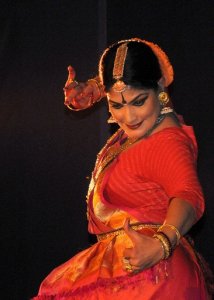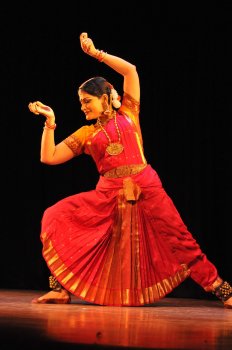
|   |

|   |
Geeta Chandran explores Sanskrit treasures: Drishya Kavya - Dr. Sunil Kothari e-mail: sunilkothari1933@gmail.com Photos: Natya Vriksha/ S Dhillon August 5, 2012 Celebrating 3rd August as Sanskrit Day at Hindi Bhavan, New Delhi, before a packed audience of Sanskrit lovers, rasikas, connoisseurs, celebrated Bharatanatyam exponent Geeta Chandran delighted the audience with her select treasure trove of Sanskrit compositions, all choreographed by her. By a happy coincidence, on Raksha Bandhan day, I saw her rehearsal at her well appointed residence with complete musical support, Rajiv Chandran keeping track of time and at times explaining to me, where I did not have enough information about the Sanskrit text chosen for the program. It was a sheer delight to watch the rehearsal. I used to earlier attend rehearsals to enter the world of dance created by the dancer. As a critic, it helped me a lot to understand the chosen theme, the text, the music and the choreography.  Next day, what I saw the previous evening was transformed into sheer visual poetry, what in Sanskrit, Kalidasa has described as Drishya Kavya. Geeta epitomised it in a telling manner. Blessed with a mobile visage, dimples and an ability to register nuances with great ease, a figure with arresting stage presence, Geeta could evoke majestic persona, appropriate to the character she would depict. Also when one has a team of musicians like nattuvanar Aiyappa Shankar, mridangist Chandrasekhar, vocalist Sudha Raghuraman and her husband flautist Raghuraman, the total configuration promises rasanubhava, the relish of a high standard. And if one is fortunate to have love for Sanskrit, one is immersed into poetry through dance and music, and the joy is multiplied. No wonder Abhinavagupta has mentioned the state as 'vigalitavedyantara'- where one forgets worldly worries and is in another state oblivious of worldly worries and is transported to other world. Beginning with Adi Shankaracharya's Shivamahapanchakshara stotra, Geeta evoked the majestic form of the Lord, whose ornaments are serpents, who is besmeared with ashes, whose clothes are directions, his vehicle is Nandi, his consort is Gauri, his ornaments are the sun and the moon and he has a third eye, his yakshaswarupa, his jata, his pinaka, bow - ah ,what a wealth of images Geeta created in a trice! The art of suggestion, vyanjana, employed by her like Shiva with his hair loosened to receive Ganga, trampling the Muyalaka by his foot, holding his form in abhaya hasta, the eternal form of dancing Shiva, as seen in sculpture, Geeta holding her frame in a rock steady pose and with Namah Shivaya resonating in the air, the mood was established for relishing the succeeding numbers. Selecting shlokas for description of Kamadeva and Rati from Damodaragupta's Kuttanimata, Geeta sculpted Kamadeva astride his vehicle parrot, holding bow made of sugarcane, with string of bees, Rati whose face as it were made of hundreds of lotuses, on which her beloved Kamadev plants a kiss, his flowery arrows evoking love and from there to the Vasanta ritu, the spring season, and Jayadeva's 'Lalitalavangalataparishilana' - what exquisite alliteration. The musical quality of the words beginning with 'La' in the ashtapadi, was exquisite transition. Sakhi telling Radha to look at Krishna playing with other gopis on the bank of Yamuna, in time of spring, and spring with its intoxicating effect upon one and all, Krishna dallying with other gopis, at times playing Rasa with sticks, at times moving in circles holding hands, the atmosphere full of joy, sakhi beseeching Radha to go and follow Krishna - the entire presentation led the audience to the 'Vasanti' mood.  It is said 'Upama Kalidasasya' - none excels Kalidasa in the use of the figure of speech Upama, simile. It was a sheer pleasure to watch the similes transformed into visuals, so well crafted by Geeta. After Grishma, the summer, when Varsha ritu, the monsoon season arrives - the arrival is described by Kalidasa in arresting images. The gathering of clouds is like the elephants, the sound of clouds like the drum beats, the arrival is like a majestic king with all regalia, the lightning like flag! Geeta with angikabhinaya and a joy coursing through her frame brought all that alive! But wait, there is more to come. When the torrential rains came, the nayikas clung to the nayakas, whom they earlier were in no mood to forgive. The rivers broke banks like women wanton and abundant - one has to immerse in Kalidasa's Ritusamhara to relish the rasa again and again. The depiction of shringara with 'nirantara shayana' words and Geeta's relaxing on floor, depicting lovers in embrace was a brilliant ending. I have enjoyed Amarushataka but have seen only a few dancers selecting rare stanzas for dance. 'Gate premamannade, pranaya bahumane vigalite' dwells on a state where the fragrance of love has vanished. The nayika tells her sakhi that she saw her estranged beloved walking in a crowd like an ordinary person and nothing happened to her! Whereas earlier her heart would break into hundred smithereens and recalling their intense love play, what is it that now her heart does not behave in that manner? The ways of heart and love are so mysterious. The nayika is firm and calm. She fetches water, dries clothes, follows her daily chores, and expresses all this in a calm and cool manner. Amaru captures such subtle experiences in his inimitable style. Geeta captured those moods with ease and command over expressions. Geeta concluded with Chandrasekhara swamigal's 'Maitrim bhajata' composition made popular by legendary Subbulakshmi. It conveys 'shreyomukta sakaljanan', wishing good for all mankind. The feeling of ‘vishranti,’ joy of 'rasanubhava', the relish 'Natya Kaumudi' that Geeta Chandran brought, I shall remember for long. A seasoned, mature dancer, with deep interest in Sanskrit, knowledge of music, and completely immersing herself in dance, with heightened aesthetic sensibilities, Geeta has carved a niche for herself in classical Bharatanatyam world. May she continue to delight her admirers with such rare and exquisite performances, bringing Sanskrit closer to audiences. Prof. Deepali Bhanot of Sanskrit Department of Delhi University gave lucid introductions in Hindi which gave to those in the audience who did not know Sanskrit, several highlights of the presentation. Deepa's lighting was appropriate and according to the moods of the seasons. A big thank you to Delhi Sanskrit Academy for giving us such an excellent offering from Geeta Chandran. Dr. Sunil Kothari is dance historian, scholar, author and a renowned dance critic. He is Vice President of World Dance Alliance Asia Pacific India chapter, based in New Delhi. He is honored by the President of India with Padma Shri, Sangeet Natak Akademi award and Senior Critic Award from Dance Critics Association, NYC. He is a regular contributor to www.narthaki.com, the roving critic for monthly magazine Sruti and is a contributing editor of Nartanam for the past 11 years. |